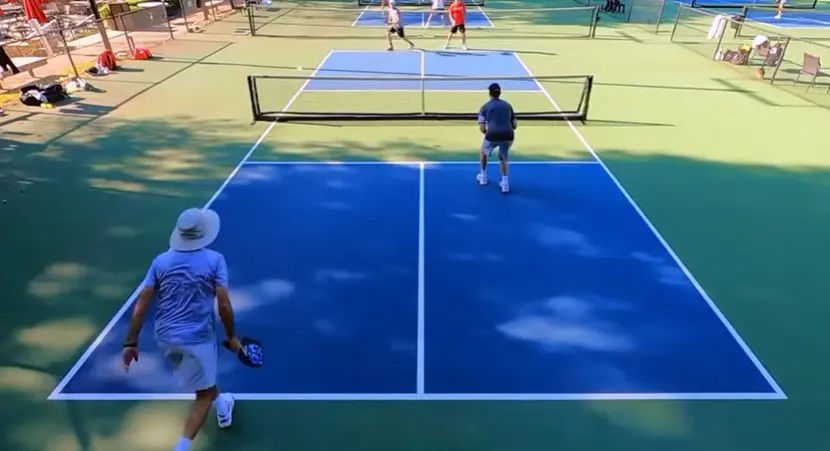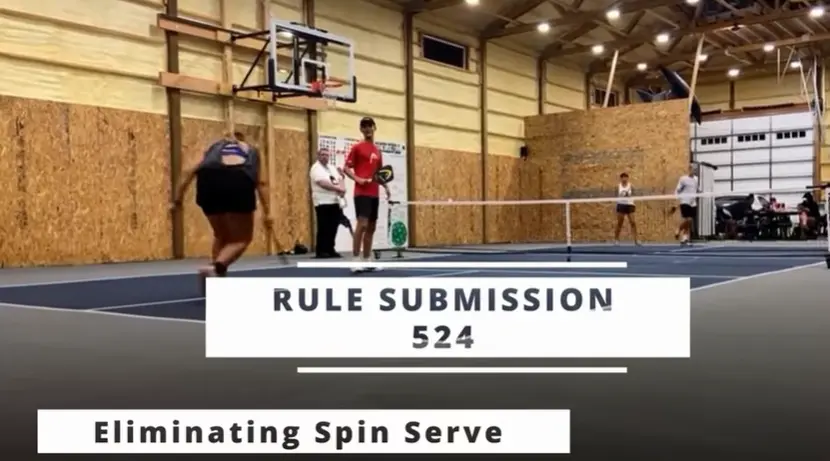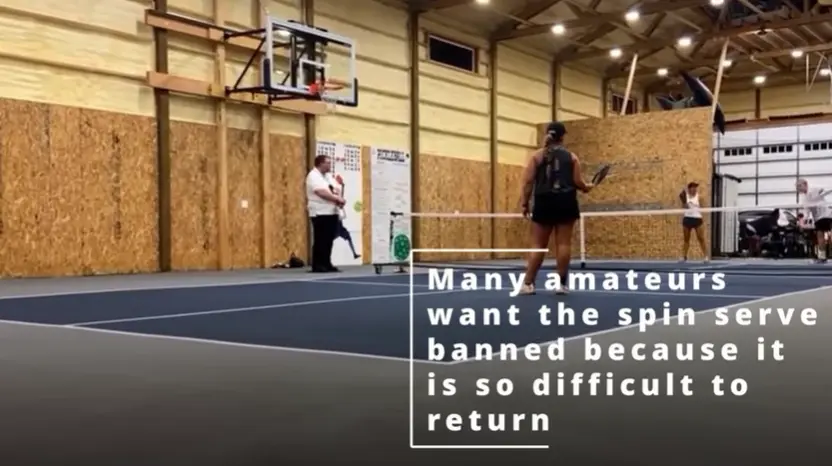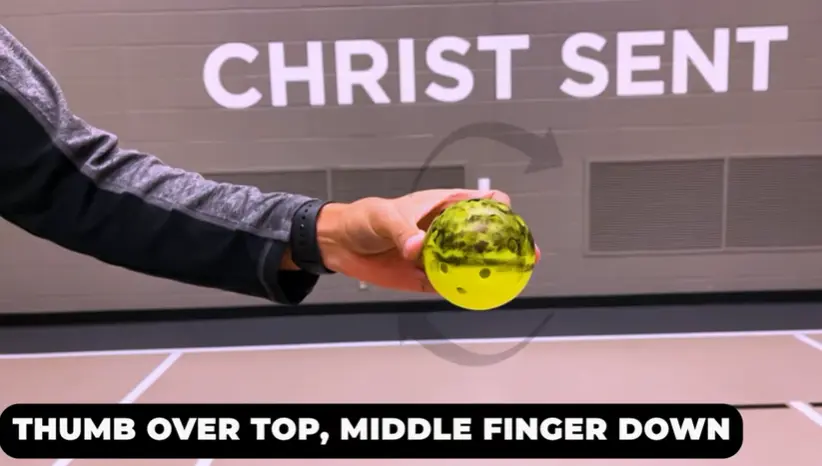Attention all Pickleball enthusiasts! The USA Pickleball has made an announcement that has sent shockwaves through the community – the one-handed pickleball pre-spun serve is now banned!
This rule change has left many players wondering why this decision was made and how it will affect their game.
Do Not Forget to Read: What Is A Fault In Pickleball?

I have written this article to provide you with all the information you need to know about the new rule changes and what it means for your playing style.
From the outlawing of the chainsaw serve to the latest ban on spin serves, we will delve into the reasons behind these rule changes and how they will impact the game of Pickleball.
Whether you are a beginner or a seasoned pro, this article will provide you with valuable insights into the world of Pickleball and keep you up-to-date with the latest changes in the sport. So, let’s dive into the world of Pickleball and explore the latest rule changes!
Do Not Forget to Read: Latest Pickleball Paddles
Pickleball Spin Serve Rules Changed Or Banned
In 2022, Zane Navratil popularized the chainsaw serve, which involved excessive spin applied to the ball before serving.
However, the PPA Tour limited the use of one hand for the serve, prompting players to try pre-serve spin at a professional level.

The USA Pickleball Rulebook only recognizes two types of legal serves: the Volley Serve and the Drop Serve. Rule 4.A.5 of the USA Pickleball Rulebook forbids applying spin to the ball before striking it for the serve.
This rule change will ban pre-spinning the ball before serving, and it will take effect in 2023.
A pre-spun serve refers to the application of spin to the ball with fingers or hand rotation before striking a volley serve. Pre-spin creates an unpredictable bounce on the opponent’s court, making it difficult to return, especially for amateur players.
The updated USA Pickleball rule book will prohibit applying any spin or manipulation of the ball from one hand before striking it with the paddle for the serve. A comprehensive review and voting system led to the decision to ban pre-spun serves.
However, this new rule does not mean that spin cannot be applied with the paddle when striking the ball. Spin can be applied to the ball with the paddle upon striking it after the ball is tossed or dropped. Top or side spin can be used as long as all the legal requirements for a serve are followed.
Backspin is difficult to apply to a volley serve since it requires a downward attack of the ball. It’s effective with a drop serve, which has fewer requirements. Each type of spin has its effect on the ball’s bounce and trajectory in the air.

Spin is created based on the angle and direction the paddle face moves as it contacts the ball, creating friction. The severity of spin is determined by the speed and angle of the paddle movement as it hits the ball.
Applying spin to a serve can help elevate a player’s game once the fundamental pickleball skills are mastered. Therefore, it’s worthwhile to practice the application of spin to the serve and dink.
Do Not Forget to Read: What is Double Bounce Rule in Pickleball?
Reasons Behind Banning Pre-Spun Serves
The 2023 rule change will have a significant impact on the pickleball community, especially those who rely on pre-spun serves to gain an advantage.
Professional players will have to adjust their game and find new ways to create an unpredictable bounce on the opponent’s court. Amateur players will have a fairer chance of returning serves, which will make the game more enjoyable and competitive.
Safety Concerns
One of the primary reasons for banning pre-spun serves in pickleball is safety. The smaller court size of four pickleball courts placed on the space of one tennis court makes it challenging for players to safely return the ball.
The one-handed spin serve, in particular, can cause the ball to bounce significantly left or right, potentially putting players in danger of hitting walls or fences.
Low Adoption Rates
Another reason for banning pre-spun serves in pickleball is the low adoption rates, especially by female players. The rules committee expected players to “read” the serve over time and adapt to it.
However, the one-handed spin serve did not materialize across the skill spectrum, particularly at the recreational play level. This impacted the decision to ban the serve, as women playing mixed doubles against men with advanced expertise in the spin serve were at a disadvantage.
Pro Player Input
Pro players who used the one-handed spin serve, some to great advantage, advised the committee to eliminate it, citing the impact it had on the game.
The committee did not provide a clear reason why the pro players advised eliminating the spin serve. However, their input influenced the decision to eliminate the one-handed spin serve due to its impact on the game.
Rule Change for Sportsmanship
The most meaningful change in rules implemented for 2023 was that players should not wear clothing that matches the ball color to promote sportsmanship.
The rule change is intended to promote fairness and prevent distractions during play. The rule does not apply to footwear, so chartreuse shoes are still allowed.
Do Not Forget to Read: How High Should A Pickleball Net Be?
How Players Apply Spin To The Ball Prior To Striking A Volley Serve:
To apply spin to the ball prior to striking a volley serve, players use their fingers or hand rotation to pinch the ball, which puts excessive spin on it before striking with the pickleball paddle.

This pre-spin creates an unpredictable bounce on the opponent’s court and can be very difficult to return, especially for amateur players. The severity of spin applied is determined by the speed and angle of the paddle movement as it hits the ball.

Spin is created based on the angle and direction the paddle face moves as it contacts the ball, creating friction. Each type of spin has its effect on the ball’s bounce and trajectory in the air.
Advantage Of Pre-Spun Serve In Pickleball:
The advantage of using a pre-spun serve in pickleball is that it can create an unpredictable bounce on the opponent’s court, making it more difficult for them to return the serve.
This can give the server an advantage and allow them to start the point on the front foot. In addition, pre-spinning can also allow for more control over the ball’s trajectory and increase the likelihood of it landing in a specific area of the opponent’s court.
Do Not Forget to Read: What Are The 5 Rules Of Pickleball
Difference Between Pre-Spinning And Applying Spin To The Ball After Tossing Or Dropping It:
The key difference between pre-spinning and applying spin to the ball after tossing or dropping it is the timing of when the spin is applied.
With pre-spinning, the player applies spin to the ball before striking a volley serve, while with post-spinning, the spin is applied after the ball has been tossed or dropped and before striking the serve.
In 2023, the updated USA Pickleball rulebook will forbid applying any spin or manipulation of the ball from one hand before striking it with the paddle for the serve. Once the ball is tossed or dropped, spin may be applied to the ball with the paddle upon striking it.
This could be in the form of top or side spin, as long as all the requirements of a legal pickleball serve are followed. Backspin is difficult to apply to a volley serve as it requires a downward attack of the ball.
Do Not Forget to Read: Pickleball Court Color Schemes
New Volley Serve Rule
The new volley serve rule reads as follows:
4.A.5 The Volley Serve. The server shall use only a one-handed spin serve to release the ball to perform the serve. While some natural rotation of the ball is expected during any release of the ball from the hand, the server shall not impart manipulation or spin on the release of the ball immediately prior to the serve. The server’s release of the ball must be visible to the referee and the receiver. If the referee determines that manipulation or spin has been imparted, or the release of the ball is not visible, the referee shall call for a reserve.
In matches without a referee, the server’s release of the ball must be visible to the receiver. The server shall not impart manipulation or spin on the release of the ball immediately prior to the serve. If the receiver determines that manipulation or spin has been imparted, or the release of the ball is not visible, the receiver shall call for a reserve immediately after the serve occurs. Exception: A player who has the use of only one hand may use their hand or paddle to release the ball to perform the serve.
In addition, to serve rules, there is also a change in equipment time-outs. Even if the team is out of time-outs, players can use equipment time-outs as they are put under a special category. Also, there’s a new rule that states your clothing color should not match the ball’s color during the game. If you’re wearing clothing matching the color, you may be requested to change it.
Now, in 2023 if the wrong score is called, you can return or serve to correct the score. Furthermore, there are some service motions, line calls, rejection of rally scoring, and editorial changes too.
Explanation of the Volley Serve Rule Change
One of the key aspects of the game is the serve, which is used to begin play. However, the sport has seen a recent controversy over pre-spun serves and their impact on the game. In response, USA Pickleball made a significant rule change to address the issue.
The original purpose of the pickleball serve was to begin play, not to score points by itself. However, some players have been using pre-spun serves to gain an unfair advantage over their opponents.
These serves involve applying spin to the ball with your fingers or hand rotation before striking a volley serve. This creates an unpredictable bounce on the opponent’s court, making it difficult to return, especially for amateur players.
USA Pickleball’s decision to ban pre-spun serves is based on several reasons. Most players are unable to effectively hit or return a pre-spun serve, which requires more court space for the receiver to react.
Only a few players can master the pre-spun serve, giving them an unfair advantage. This makes the game less accessible to newcomers and casual players. Long rallies are a fun aspect of pickleball, and difficult serves detract from this.
To address the issue, USA Pickleball’s rules committee decided to change the rule regarding the volley serve. The new rule now forbids applying spin to the ball before striking it for the serve.
This means that pre-spun serves are no longer allowed in the game. The serve should simply be a means to begin play, not a way to score by itself.
What does the new rule mean for players? It means that players must now rely on their skill and technique to win points, rather than relying on an unfair advantage from a pre-spun serve.
The rule change also helps level the playing field, making the game more accessible to newcomers and casual players. It encourages longer rallies and emphasizes the importance of mastering the fundamentals of the game.
Do Not Forget to Read: Chainsaw Serve Pickleball
Effects Of Pre-Spun Serves On Newcomers And Casual Players
This ban has caused controversy among players, with some arguing that the pre-spun serve is a legitimate technique that skilled players have developed to gain an advantage.
However, the ban is not intended to limit players’ ability to use their skill or strategy, but rather to improve accessibility and promote sportsmanship.
Similar to pickleball, finger spin serving has been banned in table tennis since the 1930s for similar reasons. The small playing surface of both sports does not allow sufficient time for players to react to a spin serve, making it difficult for beginners and casual players to keep up.
Players are only allowed to manipulate the ball with their paddle during a pickleball match, so the serve should be treated the same.
One concern raised is that without a referee, the receiver may call for a replay if they believe the server has made an illegal serve, which can be difficult to accurately determine at a distance of 44 feet.
Additionally, allowing spin serves using the paddle may cause confusion or disagreement between players, as the receiving player may incorrectly attribute a ball’s spin to an illegal serve instead of skillful use of the paddle.
Some believe that rules should be made with consideration for the best players, but allowing pre-spun serves at higher levels and by professionals makes watching matches more exciting.
Pre-spun serves are difficult to do successfully, and likely won’t be used much at lower levels. The ban may help create a more level playing field for all players, as it eliminates the advantage that skilled players have over beginners and casual players.
The controversy over the ban highlights the ongoing debate over the role of skill and strategy in competitive sports.
While some argue that techniques like the pre-spun serve are an essential part of the game, others believe that such techniques may make the game less accessible and fair for all players. Ultimately, the rules committee continuously evaluates the game’s rules to improve safety, fairness, and accessibility.
Frequently Asked Questions

Michael Stevenson
Hi, my name is Michael Stevenson and I’m a passionate pickleball player. I’ve been playing the game for many years and I’m pretty highly skilled at it. Pickleball is one of my favorite topics so naturally, I love to write about it.
Whether it’s tips for beginners, guides for experts, reviews of new paddles, or advanced playing techniques – if it relates to pickleball then I have something interesting to write about it. So if you’re looking for entertaining and informative information on the topic of pickleball, look no further than my written works!